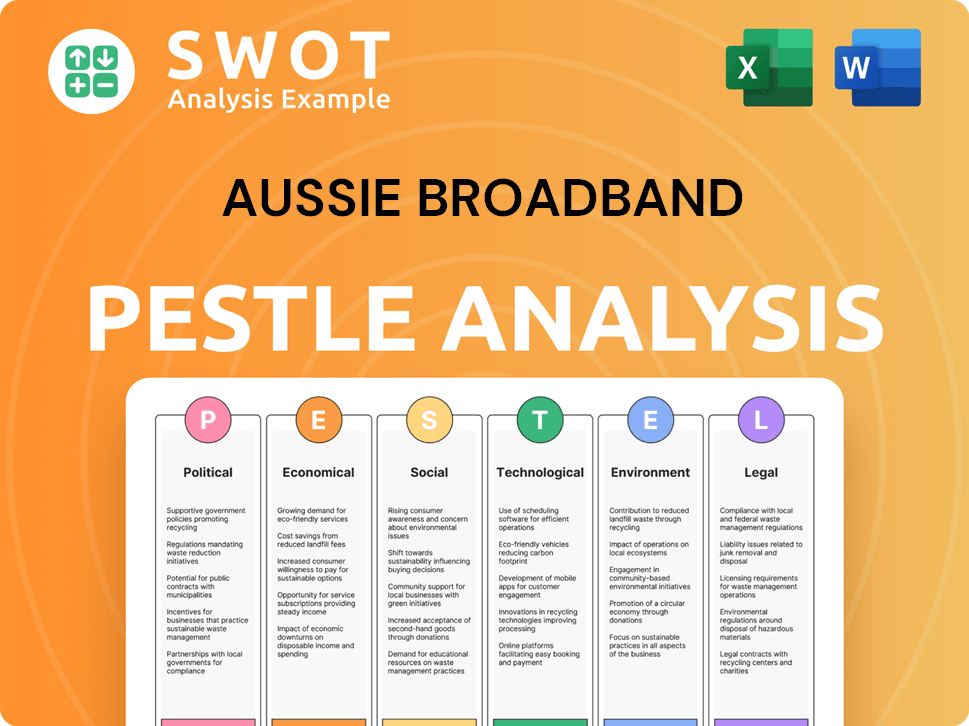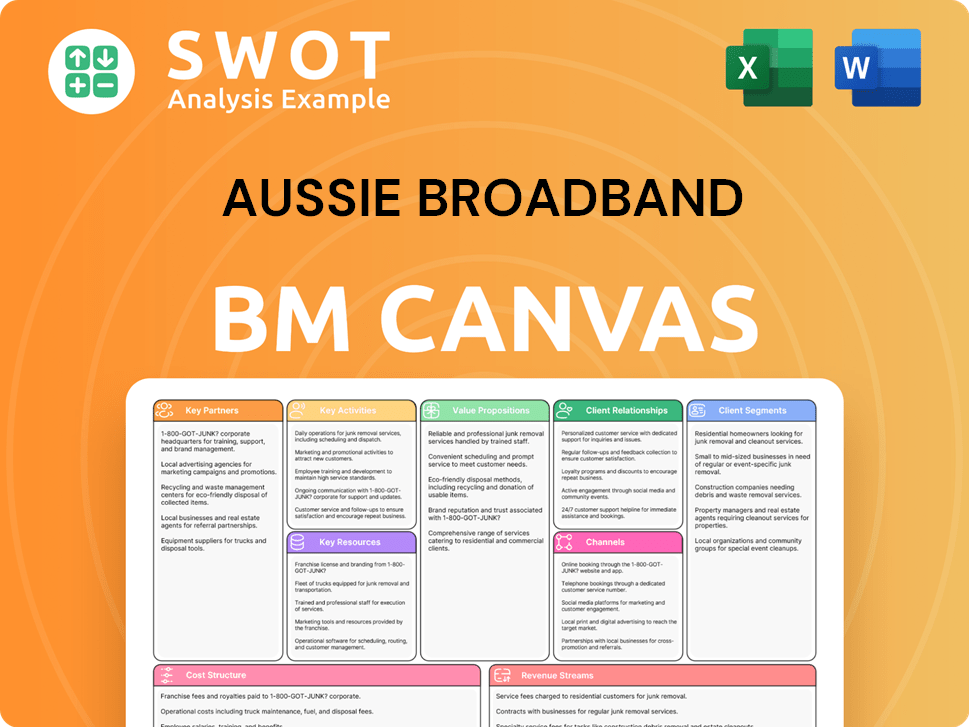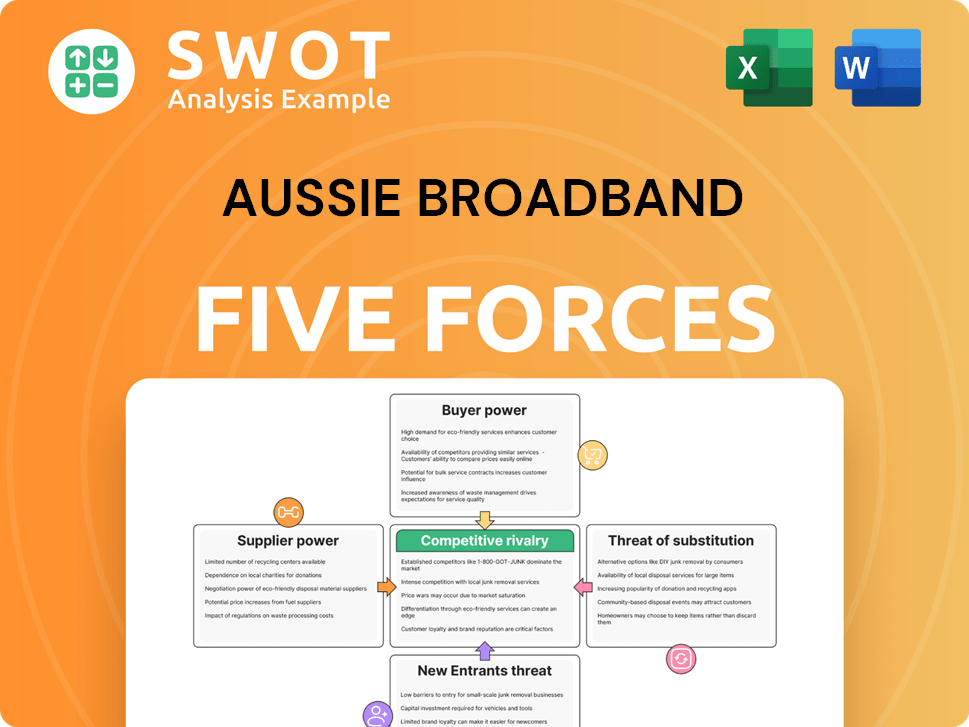Aussie Broadband Bundle
Can Aussie Broadband Conquer the Australian Telecoms Titans?
The Australian telecommunications sector is a battlefield, where customer loyalty and network quality reign supreme. Aussie Broadband has stormed onto this scene, disrupting the established order with its customer-centric approach. This analysis dives deep into Aussie Broadband's strategic positioning, examining its rivals and revealing its unique strengths in a cutthroat market.

Founded in 2008, Aussie Broadband has rapidly evolved from a regional ISP to a national powerhouse. The Aussie Broadband SWOT Analysis offers a comprehensive look at the company's strengths, weaknesses, opportunities, and threats within the competitive landscape. This exploration will dissect the company's strategies, analyze its market share, and compare it against key competitors like Telstra and Optus, providing insights into its financial performance and future strategy within the broadband market Australia.
Where Does Aussie Broadband’ Stand in the Current Market?
Aussie Broadband has established a distinct market position within the Australian telecommunications industry, primarily by focusing on customer service and network quality. The company has consistently demonstrated strong growth in NBN (National Broadband Network) connections. As of early 2024, the company continued to show solid growth in its broadband subscriber base.
The company primarily offers NBN and other internet plans, catering to both residential and business customers. Its geographic presence spans across Australia, having successfully transitioned from a regional focus to a national provider. This expansion reflects its ability to attract new customers in a competitive market. Owners & Shareholders of Aussie Broadband have seen the company's strategic moves pay off.
Aussie Broadband has positioned itself as a premium service provider, emphasizing speed, reliability, and customer support, which differentiates it from budget-focused competitors. This positioning has allowed it to attract customers willing to pay more for a superior internet experience. Over time, the company has also diversified its offerings, venturing into mobile services and voice solutions, further broadening its appeal and expanding its addressable market.
Aussie Broadband has steadily increased its market share in the Australian broadband market. While specific figures fluctuate, the trend indicates consistent growth. This growth is fueled by strong customer acquisition and retention strategies.
The company consistently ranks highly in customer satisfaction surveys. Its focus on customer service is a key differentiator. High satisfaction levels contribute to strong customer retention and positive word-of-mouth referrals.
Aussie Broadband has demonstrated robust financial performance. Its half-year FY24 results showed healthy revenue growth and improved profitability. The company's financial health supports its ability to invest in infrastructure and services.
The company offers a range of services, including NBN plans, mobile services, and voice solutions. This diversification helps to broaden its appeal to both residential and business customers. The variety of offerings enhances its competitive position in the broadband market Australia.
Aussie Broadband's competitive advantage lies in its focus on customer service, network quality, and a premium service approach. This strategy allows it to attract customers who prioritize reliability and support. The company's strong brand reputation and consistent positive feedback contribute to its success.
- Customer Service: High ratings and responsive support.
- Network Quality: Reliable and fast internet speeds.
- Premium Positioning: Catering to customers willing to pay more for better service.
- Diversified Offerings: Including NBN, mobile, and voice solutions.
Aussie Broadband SWOT Analysis
- Complete SWOT Breakdown
- Fully Customizable
- Editable in Excel & Word
- Professional Formatting
- Investor-Ready Format

Who Are the Main Competitors Challenging Aussie Broadband?
The Growth Strategy of Aussie Broadband operates within a highly competitive Australian telecommunications market. This market is characterized by both direct and indirect competition, with a diverse range of players vying for market share. Understanding the competitive landscape is crucial for evaluating the company's position and future prospects within the Australian internet service providers sector.
The competitive dynamics are shaped by the presence of major telecommunications companies, smaller NBN resellers, and emerging players. These entities compete on various fronts, including pricing, network coverage, bundled services, and customer service. The ongoing evolution of technology and market consolidation further influences the competitive environment, making it essential to analyze the key players and their strategies.
The Australian broadband market is dynamic, with constant shifts in market share and competitive strategies. Financial performance, customer satisfaction, and infrastructure investments are key factors influencing the competitive landscape. Recent data indicates that the market continues to evolve, with companies adapting to changing consumer demands and technological advancements.
Telstra, as the incumbent, holds the largest customer base and extensive infrastructure. It challenges the company through its vast network reach and bundled services. Telstra's dominance in the telecommunications industry is supported by its significant investments in network upgrades and a strong brand presence.
Optus is the second-largest player, competing vigorously on price, bundled offerings, and mobile integration. Optus often engages in aggressive marketing campaigns to attract customers. The company's competitive strategy includes offering attractive deals and expanding its service portfolio.
TPG Telecom, through brands like iiNet, Internode, and Vodafone, offers a wide range of internet and mobile plans. It frequently competes on price, leveraging its extensive customer base. TPG's strategy focuses on providing cost-effective services and expanding its network infrastructure.
A multitude of smaller NBN resellers and regional ISPs target niche markets or offer specialized services. These competitors often focus on specific customer segments or geographical areas. Their strategies involve providing tailored services and competitive pricing.
Emerging players, particularly those focusing on fixed wireless or new fiber deployments, could disrupt the traditional competitive landscape. These companies often leverage new technologies to offer innovative services. Their growth depends on their ability to capture market share through differentiated offerings.
Ongoing merger and acquisition activities, such as the proposed merger between TPG Telecom and Vocus Group, can reshape competitive dynamics. These consolidations may lead to increased market power and potentially reduce the number of independent players. The competitive landscape is subject to change due to these activities.
Several factors influence the competitive landscape within the broadband market Australia. Understanding these factors is crucial for assessing the company's strategic position and prospects. The key competitive elements include pricing, network coverage, bundled services, and customer service.
- Pricing: Competitive pricing is a key factor, with companies constantly adjusting their plans to attract customers.
- Network Coverage: Extensive network coverage, particularly in regional areas, is essential for reaching a broader customer base.
- Bundled Services: Offering bundled services, such as internet, mobile, and entertainment, can enhance customer value.
- Customer Service: High-quality customer service is crucial for customer satisfaction and loyalty.
Aussie Broadband PESTLE Analysis
- Covers All 6 PESTLE Categories
- No Research Needed – Save Hours of Work
- Built by Experts, Trusted by Consultants
- Instant Download, Ready to Use
- 100% Editable, Fully Customizable

What Gives Aussie Broadband a Competitive Edge Over Its Rivals?
The competitive landscape for Aussie Broadband, a prominent player in the Australian internet service providers market, is shaped by its unique strengths. Aussie Broadband distinguishes itself through superior customer service and network performance, fostering strong brand loyalty. This approach has enabled it to carve out a significant niche in the broadband market Australia, competing effectively against larger telecommunications industry giants.
Aussie Broadband's strategic focus on customer satisfaction and network reliability has been pivotal in its growth. They have invested heavily in their network infrastructure to provide consistent and reliable internet service. This commitment, coupled with transparent communication about network performance, has built trust with its customer base, setting it apart from competitors. The company's agility in adapting to market demands further strengthens its competitive position.
The company's commitment to customer service is a key differentiator. Unlike many competitors, Aussie Broadband has built a reputation for responsive and effective customer support. This focus on customer experience fosters strong brand loyalty, which is a significant differentiator. For example, in 2024, Aussie Broadband consistently scored highly in customer satisfaction surveys, reflecting its dedication to providing excellent service.
Aussie Broadband prioritizes customer service, setting it apart in the Australian internet service providers market. Their responsive and effective support builds strong brand loyalty. This approach has led to high customer satisfaction ratings and positive reviews, solidifying its competitive advantage.
Aussie Broadband invests in its network infrastructure to ensure consistent and reliable internet service. Their proactive management of NBN Points of Interconnect (POIs) minimizes congestion. This technical proficiency leads to higher speeds and fewer dropouts, addressing common customer pain points.
Aussie Broadband quickly adapts to market demands, introducing innovative solutions. They offer a range of NBN plans with varying speeds and data allowances. This flexibility, coupled with business-grade services, caters to diverse customer segments, enhancing their competitive edge.
The company builds trust through transparent communication about network performance and outages. This openness fosters customer loyalty and reinforces its commitment to providing reliable service. This approach helps in building a strong reputation in the competitive landscape.
Aussie Broadband's competitive edge lies in its customer-centric approach and superior network management. This focus enables the company to maintain a strong position within the Australian internet service providers market. The company's ability to quickly adapt to market demands and introduce innovative solutions further enhances its competitive advantage. For more details, explore the Revenue Streams & Business Model of Aussie Broadband.
- Customer Service: High customer satisfaction scores and responsive support.
- Network Performance: Investment in infrastructure for reliable speeds and fewer dropouts.
- Product Agility: Quick adaptation to market demands with diverse NBN plans.
- Transparency: Open communication about network performance and outages.
Aussie Broadband Business Model Canvas
- Complete 9-Block Business Model Canvas
- Effortlessly Communicate Your Business Strategy
- Investor-Ready BMC Format
- 100% Editable and Customizable
- Clear and Structured Layout

What Industry Trends Are Reshaping Aussie Broadband’s Competitive Landscape?
The Australian telecommunications industry, and consequently the Aussie Broadband competitive landscape, is undergoing significant transformation. Key drivers include technological advancements, regulatory changes, and evolving consumer preferences. These factors shape both the challenges and opportunities for internet service providers (ISPs) like Aussie Broadband within the broadband market Australia.
Understanding the competitive dynamics is crucial for assessing Aussie Broadband's position. The company faces competition from major players and smaller, niche providers. The telecommunications industry landscape is influenced by infrastructure investments, pricing strategies, and service differentiation. The company's future hinges on its ability to adapt to these changes and capitalize on emerging trends.
The Australian broadband market is heavily influenced by the NBN rollout and upgrades, impacting speed and access. Consumer demand for higher speeds and bundled services is growing. Regulatory changes, like those affecting NBN pricing, significantly impact Internet service providers.
Maintaining premium service differentiation in a competitive market is a key challenge. Competition from larger providers with greater resources poses a threat. Managing customer expectations for increasing speeds and data usage while ensuring profitability remains a balancing act.
The ongoing demand for reliable internet services, particularly for remote work and streaming, benefits Aussie Broadband. Expansion into underserved areas and strategic partnerships can fuel growth. Diversification into bundled services like mobile and voice offers additional revenue streams.
Focusing on bundling services and enhancing the value proposition is crucial. This may involve smart home integration or specialized business solutions. Staying competitive requires continuous innovation and adaptation to market changes.
The Aussie Broadband competitive landscape is dynamic, shaped by technological progress, regulatory changes, and consumer demands. The company must navigate challenges while capitalizing on opportunities to maintain its market position. Strategic initiatives, such as service bundling and expansion, will be vital for future success.
- The NBN rollout and associated infrastructure upgrades are central to the industry.
- Competition from established providers and new entrants is intensifying.
- Customer expectations for speed, reliability, and bundled services are rising.
- Strategic partnerships and service diversification are key growth drivers.
Aussie Broadband Porter's Five Forces Analysis
- Covers All 5 Competitive Forces in Detail
- Structured for Consultants, Students, and Founders
- 100% Editable in Microsoft Word & Excel
- Instant Digital Download – Use Immediately
- Compatible with Mac & PC – Fully Unlocked

Related Blogs
- What are Mission Vision & Core Values of Aussie Broadband Company?
- What is Growth Strategy and Future Prospects of Aussie Broadband Company?
- How Does Aussie Broadband Company Work?
- What is Sales and Marketing Strategy of Aussie Broadband Company?
- What is Brief History of Aussie Broadband Company?
- Who Owns Aussie Broadband Company?
- What is Customer Demographics and Target Market of Aussie Broadband Company?
Disclaimer
All information, articles, and product details provided on this website are for general informational and educational purposes only. We do not claim any ownership over, nor do we intend to infringe upon, any trademarks, copyrights, logos, brand names, or other intellectual property mentioned or depicted on this site. Such intellectual property remains the property of its respective owners, and any references here are made solely for identification or informational purposes, without implying any affiliation, endorsement, or partnership.
We make no representations or warranties, express or implied, regarding the accuracy, completeness, or suitability of any content or products presented. Nothing on this website should be construed as legal, tax, investment, financial, medical, or other professional advice. In addition, no part of this site—including articles or product references—constitutes a solicitation, recommendation, endorsement, advertisement, or offer to buy or sell any securities, franchises, or other financial instruments, particularly in jurisdictions where such activity would be unlawful.
All content is of a general nature and may not address the specific circumstances of any individual or entity. It is not a substitute for professional advice or services. Any actions you take based on the information provided here are strictly at your own risk. You accept full responsibility for any decisions or outcomes arising from your use of this website and agree to release us from any liability in connection with your use of, or reliance upon, the content or products found herein.